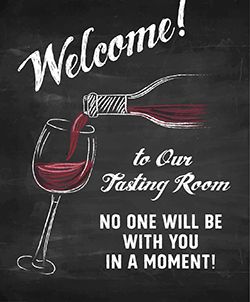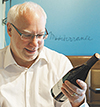Room for Improvement
Wine doesn’t sell itself in tasting rooms

Wow! The latest Economic Impact Study commissioned by the Oregon Wine Board shows that a remarkable 24 percent of the state’s bottled wines were sold direct to consumers (DTC) in 2014. These are the highest margin, most desirable sales a winery can make. Good on ya’, Oregon!
It’s all the more unfortunate, therefore, to realize that too many Oregon wineries are leaving so much more money on the table through poor tasting room experiences.
Every winemaker wants to believe that once people taste their ambrosial wines, they will fall in love with the winery and be a customer for life. In the real world, though, people only come back to a winery where they can feel a part of the brand — as well as loving the wines.
The best tool a winery has to bond people to their brand is the experience they offer in their tasting room. There are more than 600 wineries making wonderful Oregon wine, but not all of them offer an equally wonderful wine experience for consumers to fall in love with. It’s a major lost opportunity — for consumers as much as for wineries.
Having spent a number of months manning the tasting room of a new winery that is a consulting client of mine, I have personal experience of how powerful a positive tasting room experience can be in winning customer loyalty.
So imagine my disappointment when, last fall, my wife and I took an impromptu mid-week mini-tour of some northern Willamette Valley winery tasting rooms. I was dismayed by the lamentably lackluster hospitality we encountered.
One winery stood out as emblematic. It was a nationally known name with a strong heritage and top reputation. Yet when we walked into the sparsely decorated, impersonal feeling tasting room, no one welcomed us. Two hosts were behind the tasting bar. One was engaged with a young couple who was tasting; the other seemed to disappear upon our arrival.
No one said “Welcome! We’ll be with you in a moment.”
So we waited.
Despite the history of the winery, there was almost nothing for us to look at while we waited — no graphics depicting their heritage, no enticing pictures of harvest, no maps of vineyards or statements of winemaking intent. All we could do was peruse the tasting menu.
To be frank, I considered leaving but was afraid I might be recognized by someone I knew at the winery and didn’t want to seem an ass. Finally, the couple left, and the hostess turned to us. “What can I pour for you?” she asked.
Irritated, I wanted to reply “I don’t know, why don’t you tell me something about your wines to help me decide.” Instead, I just said “Pinot Noir.”
We weren’t asked about our wine preferences; the hostess didn’t engage us to form a connection and understand our needs; no one invited us to purchase a bottle for tonight’s dinner; and no one mentioned their wine club.
And so it went, in varying degrees, at many of other wineries we visited. If I had been unacquainted with any of these wineries, my visits gave me no reason to return. Sure, the wine was good. But guess what? There are 600 other Oregon wineries making good wine. Why would I want to come back to these wineries where the tasting experience was so unmemorable?
That’s the anecdotal evidence. Here’s some corroborating statistical evidence.
In a recent Secret Sipper Review conducted by Ferment Marketing, 24 sample wineries from Salem to Forest Grove to Hood River were visited anonymously and scored on five key measurements of an effective tasting room experience (full disclosure: I occasionally work on consulting projects with Dewey Weddington of Ferment Marketing, though I was not involved in the Secret Sipper program).
All wineries were scored using the same set of data points in these categories: Greet (15 points), Engage (30 points), Tell the Story (10 points), Ask for the Sale (25 points) and Invite Back (20 points). Each category is composed of detailed topics with each having a set level of points based on the tasting room’s performance. Points are weighted to the importance and impact on sales, the brand and customer experience.
Here are the averaged results for all the visited wineries for the following categories:
Greet (11 out of 15)
This was, by far, the best performance of all the categories. The sample wineries did a very good job of acknowledging and greeting visitors within 20 seconds of entering the tasting room. This is a vital first step in the process of providing service and hospitality.
Engage (8 out of 30)
Unfortunately, the sample wineries did a very poor job of engaging visitors in order to discover their wine preferences, motivations for visiting, and beginning a “learning dialog” with which the winery can customize and make more personal the tasting experience. This is a major area of wasted opportunity for wineries.
Tell the Story (3 out of 10)
As Ferment Marketing puts it, “This is a very sad glimpse at how poorly tasting room employees share information about the winery…” As I put it: Your story is one of the most important marketing tools you have, and every employee should be able to compellingly deliver it to your customers. If you don’t tell your story in your tasting room, you might as well close it.
Ask for the Sale (8 out of 25)
We really are just too nice in Oregon! There is no shame in asking tasting room visitor if they’d like to take a bottle home, or if they are interested in your wine club. If the winery is a hobby, then fine, who cares if you sell a bottle? But if it’s a business, then ask for the sale. Wine doesn’t sell itself. Every time you don’t ask you are ensuring a lost sale.
Invite Back (8.5 out of 20)
Why don’t we invite visitors back? It makes them feel special, it gives them an opportunity for a new experience — “We’ll be doing a special library tasting that weekend” — and it gives you a renewed opportunity to build a loyal customer.
Most people entering a tasting room are looking for a discovery. They want to find a brand to bond with. They want to feel they are part of a special wine experience. Why don’t more Oregon wineries recognize this?
Wine doesn’t sell itself (have I said that before?). A winery’s tasting room is its best way of providing guests with a wine experience bonding them to the brand. I’ll bet if wineries did their own surveys of their tasting room visitors, they’d quickly see the opportunities they are missing.
If Oregon wineries could increase the hospitality and sales effectiveness of their tasting room service, that 24 percent DTC sales could be a much larger number. And customers would benefit by feeling more connected to, and wanted by, the wineries they visit. All it takes is the recognition that a tasting room is the best place to showcase your brand, the commitment to create as memorable a wine experience as possible and the determination to hire hospitality-oriented people and reward them for selling your wine.
For more details on the Secret Sipper Survey methodology and results, contact dewey@fermentmarketing.com.

 Cole Danehower is a James Beard Award-winning wine writer and wine industry marketing consultant who has been reporting on the wines of Oregon and the Pacific Northwest since 1998.
Cole Danehower is a James Beard Award-winning wine writer and wine industry marketing consultant who has been reporting on the wines of Oregon and the Pacific Northwest since 1998.






